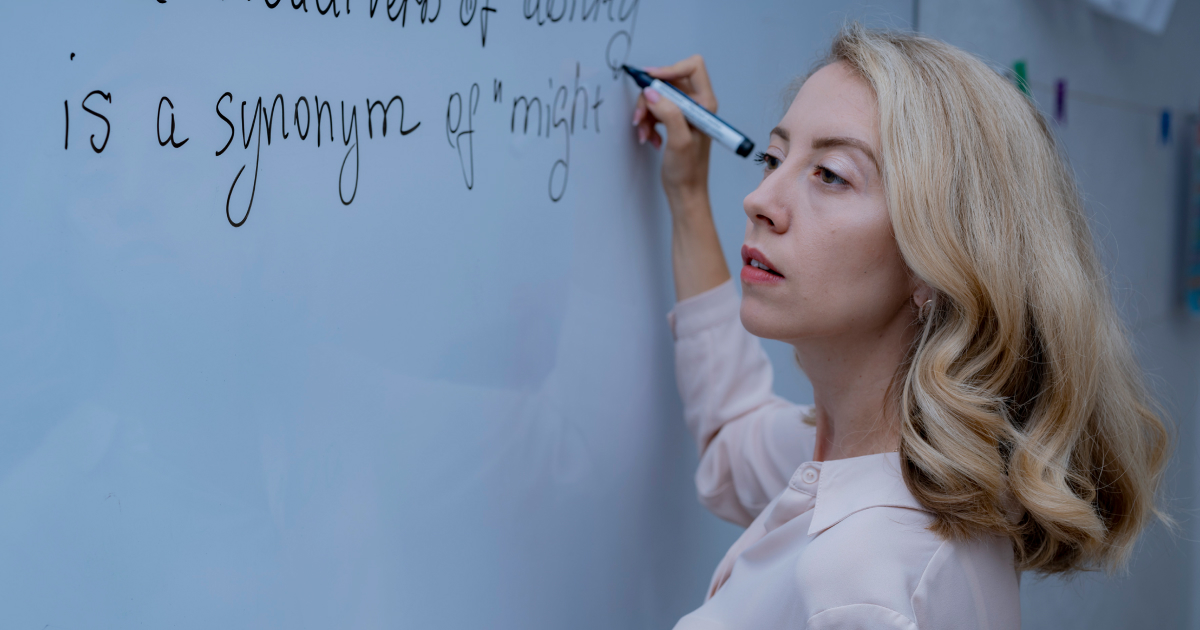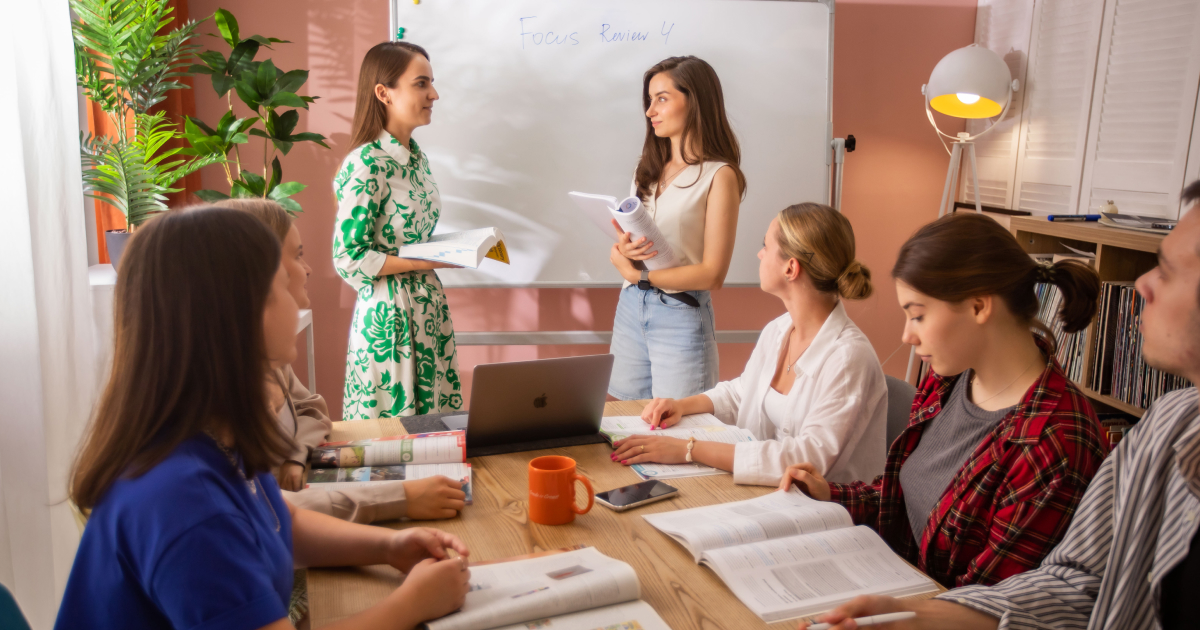Useful techniques for providing language feedback
- Teaching qualifications
- Activities
- Tips & Strategies
- Methodology

16.01.2025
Do you believe that a human mind hides mysteries and opportunities that haven’t been explored yet?
Is there a secret potential waiting to be released?
Maybe a ritual to magically reveal the enhanced capabilities and help us to retrieve and retain information with ease, elegance, and joy?
That’s what Desuggestopedia, a method developed in the 1970s by a Bulgarian scientist, Georgi Lozanov, is all about.
The etymology of the word is a story in itself.
Desuggestopedia was previously known as ‘suggestopedia’ due to the fact that something called ‘tender suggestion’ lies at the heart of the method.
Tender suggestion is a type of communication without commands or forceful recommendations, more akin to guiding the learner.
Any problems that arise are tenderly discussed.
The term ‘suggestopedia,’ in fact, is a lexical blend of the words ‘suggestion’ and ‘pedagogy,’ derived from Greek ‘paidagogos,’ consisting of ‘paidos’ (child) and ‘agogos’ (leader).
So, is it ‘suggestopedia’ or ‘desuggestopedia’ then?
Both terms are still used to refer to the same approach, as the addition of the negative prefix ‘de’ was a later adjustment to reflect changes in the focus of the method, but not its essence.
The idea is that all limitations and psychological issues imposed by societal norms prevent easy and enjoyable learning, and, therefore, need to be de-suggested.

Take control of your classroom and handle challenges with confidence!
Join our courseWhile looking for harmonious ways to guide the students, a new kind of communication was developed.
Such communication steers away from the traditional roles of an authoritative teacher and a noncritical obedient student.
The basic notion is trust and security.
The teacher demonstrates confidence in the students’ success, and once the students feel safe, they become perceptive to learning and uncovering their true potential.
Two basic types of suggestion can be used by a teacher qualified in this method: direct and indirect suggestion.
Direct suggestion works at the level of conscious processes, e.g., the teacher communicating to the students (orally or in writing) his or her belief in their success. It should be used sparingly.
Indirect suggestion is used in abundance.
These stimuli can range greatly, from voice tone, facial expression, and body posture of the teacher to general classroom setup, lighting, and decor.
All of them are meaningful and contribute to the desuggestive-suggestive process, in spite of being perceived outside conscious awareness.
After all, every element of our environment can be a stimulus, whether we identify it as such or not.
Hard and soft CLIL: what is the difference?
Dr. Lozanov, who was a psychologist, psychiatrist, neurologist, and psychotherapist, insisted that Desuggestopedia was not so much a teaching method as an art, oscillating and ever-changing, constantly being adapted to unlock the hidden potential in the learner’s mind.
He also called it ‘learning with love,’ and for a good reason.
Desuggestopedia is a profoundly humanitarian approach based on naturally high esteem for the teacher on one side and respect towards the students’ feelings on the other.
This being said, it is also considered to be one of the most extravagant, bordering on ridiculous, humanistic methods.
Some even insinuate that ‘suggestion’ is linked to hypnosis, seeing as the method only works if the learner believes it works.
It is a fact that at the very beginning of the creation of the method, Dr. Lozanov tried experimental techniques.
He incorporated yoga and even esoteric practices in order to tap into the undiscovered potential of the human mind, such as rhythmic breathing and various techniques aimed at altering states of consciousness and enhancing concentration.
He, however, denied the use of hypnosis, stating that it contradicts the principle of inner freedom of personality, which is crucial for the method.

What is wrong with the traditional way we memorise information, according to Dr. Lozanov?
To begin with, we normally tend to repeat the information frequently and intently, aloud or in writing.
The more repetitions, the better we’ll remember, right? Well, no, not really.
Then we choose small, isolated, hard-to-digest pieces of information that carry no meaning on their own and try to memorise them out of context.
Also, we concentrate our attention on the material in question; we make a conscious, well-meaning attempt at memorising it.
And last but not least, we rarely take into consideration our own state of mind, our feelings, or how motivated or how tired we are at the moment of learning.
Such an approach brings very limited and uninspiring results.
Moreover, it adds to the trauma that a lot of students already have in association with their previous learning experiences.
It might be just a slight feeling of discomfort or a deeply rooted memory of shame and frustration when nothing seemed to go right.
Either way, these experiences, elusive as they may be, turn into real obstacles and might make any further attempt at learning feel like rolling a boulder up a hill.
But how do you make your learner believe that studying is but a pleasurable walk in the park?
Is there a way to facilitate the process, accelerate learning, and uncover the true learning ability of your students?
Lozanov’s idea of tapping into the hidden resources of the mind suggests that there are ‘virgin,’ untouched resources that are not being used while practising usual learning methods.
Desuggestopedia looks for ways to release these resources, to set them free from the influence of the norms suggested by society.
Thus, the process of de-suggesting must occur, a spontaneous, not forced recovery from the trauma that hinders the learning process.

How to teach ESL: Dos and Don'ts
Read nowIn addition to the main, clearly perceived experience, there are also lots of peripheral, less obvious, background experiences.
Together, they comprise a complex of stimuli that affect our overall performance in the future.
Classroom setup is of utter importance.
Desuggestopedia recommends a brightly lit, welcoming environment with soft, calming music, often classical.
Multiple posters aimed at ‘peripheral learning’ should be hung on the walls and replaced from time to time to allow the students to be exposed to information in a non-intrusive way.
This relaxed, stress-free atmosphere provides for friendly interaction and uninhibited self-expression.
Desuggestopedia relies heavily on a highly qualified teacher, trained specifically for the purposes of the method.
One of the central features in a desuggestopedia classroom is trust in the teacher.
From the first moment on, the teacher sets the mood and introduces the spirit of delicate and relaxed interaction.
The teacher encourages the students to join in the game, acting as an older friend who possesses more knowledge and is ready to share.
The atmosphere in class is spontaneous, non-threatening, and conducive to learning.
What is environmentally-based language teaching?
In the beginning, there were three stages of a lesson: deciphering (later replaced by what was called ‘artistic introduction’), concert (consisting of active and passive memorisation séances), and elaboration.
Later, the fourth stage appeared, that of production (performance by the students).
During artistic introduction, instead of the classical explanation of the material, the teacher and the students engage in a game, conducted with mutual enthusiasm.
Very often, alternative identities are assumed for the role-play.
All the material is taught at this stage in a playful manner.
The concert session (active) is accompanied by classical musical pieces by Mozart, Beethoven, Haydn, etc.
The teacher reads and intones to the music at a normal speed, while the students actively follow the textbooks.
When the passive part of the concert session begins, music is changed to pre-classical pieces by Bach, Vivaldi, etc., with the teacher reading at a calmer, slower pace.
During the reading, the students relax and listen, and some even sit with their eyes closed.
Elaboration is often done on the next day, and during this stage, the material that has been taught is elaborated: the students sing songs and play games, while the teacher acts as a consultant, providing support.
When the time for performance comes, students practice the target language, tell each other stories and jokes, interact, and have spontaneous conversations.
The main objective of this stage is the independence and self-confidence of the students, and the teacher doesn’t interrupt or correct them.

The main premises and promises of Desuggestopedia certainly sound appealing.
First, accessing previously unknown reserves of the whole personality.
Thinking more creatively, learning more easily, memorising like never before.
Second, not getting tired.
Learning-related fatigue is gone for good, never to return.
Consequently, third, transforming both teaching and learning into a joyful, pleasant experience.
Fourth, the method always has a positive educational effect, calming aggressive tendencies in students, helping with communication and adaptation to society.
And, fifth, using the method as an element of psychotherapy, for the purposes of education and self-education, with a noticeable psychoprophylactic and psychotherapeutic effect.
5 ESL teaching methods for you to know as an English teacher
Critics of the method say that there is no solid evidence to prove or measure the supposed success of such learning and to support the ‘tapping into hidden resources’ claims.
Speaking about the procedure itself, some students strongly dislike background noise while studying, so listening to classical music for an extended period of time might not be that enjoyable.
And some may consider the idea of lengthy dialogues being read in an exaggerated manner, with Beethoven playing in the background, utterly ridiculous and irritating.
Overall, it might appear at first sight that the method is infantilising learning and treating learners as children.
This can cause some of the students to reject it from the start.
In desuggestopedia, however, infantilisation should be understood as returning to the state of curious wonder that is natural for a child.
No inhibitions are present, and new information is absorbed and appropriated with ease.
Another sticking point is that no coherent and consistent theory of language is presented; no uniform tests or quizzes are conducted.
The students are graded based on their performance in class, so those with a more introverted personality are in a definitely less favourable position.
In the absence of a clear knowledge evaluation system, students might get easily demotivated.

What are the benefits of teaching ESL?
Find outThe list of criticisms could probably be continued, and some argue that desuggestopedia is well past its prime.
However, certain elements of the method are more than welcome in our everyday classrooms.
Strain-free, cheerful acquisition of knowledge and skill, with student and teacher working together in harmony instead of stress.
Mutual respect and easy conversation, an interaction that nurtures and heals.
All of these are bound to facilitate learning and turn it into an activity to enjoy and not avoid.
Daria Matselevych
Author
Teacher of General & Business English
Comments
Leave your comment